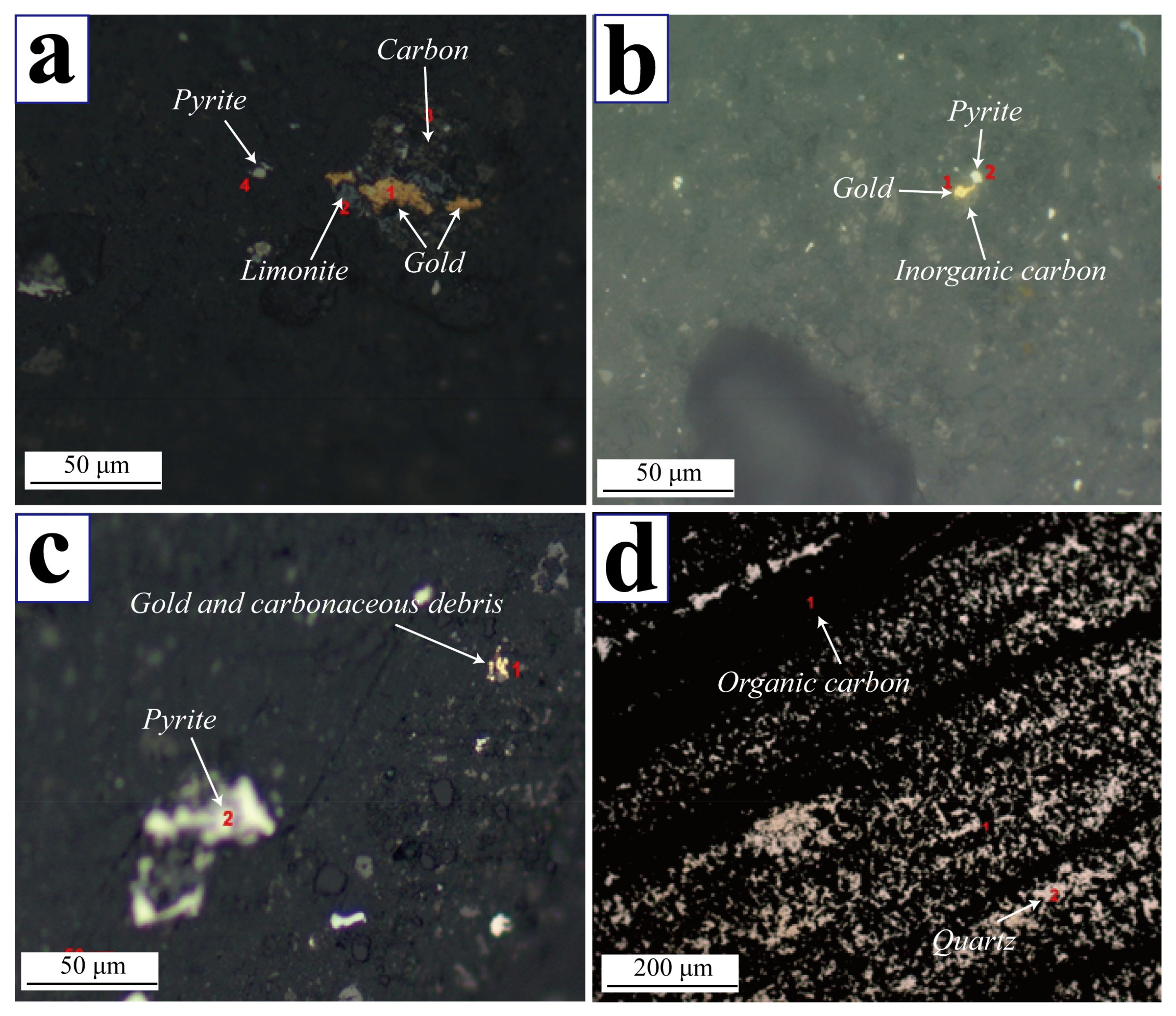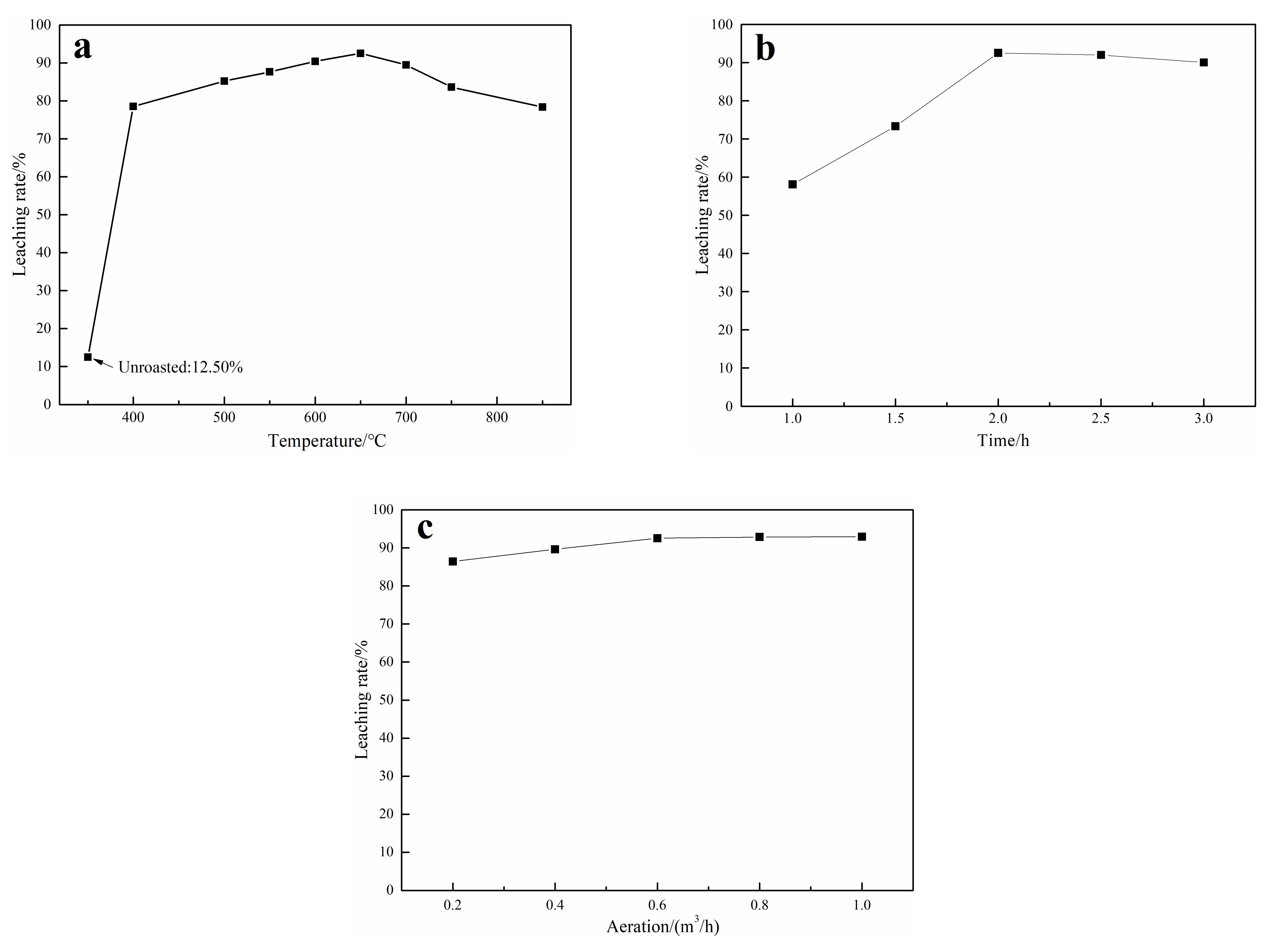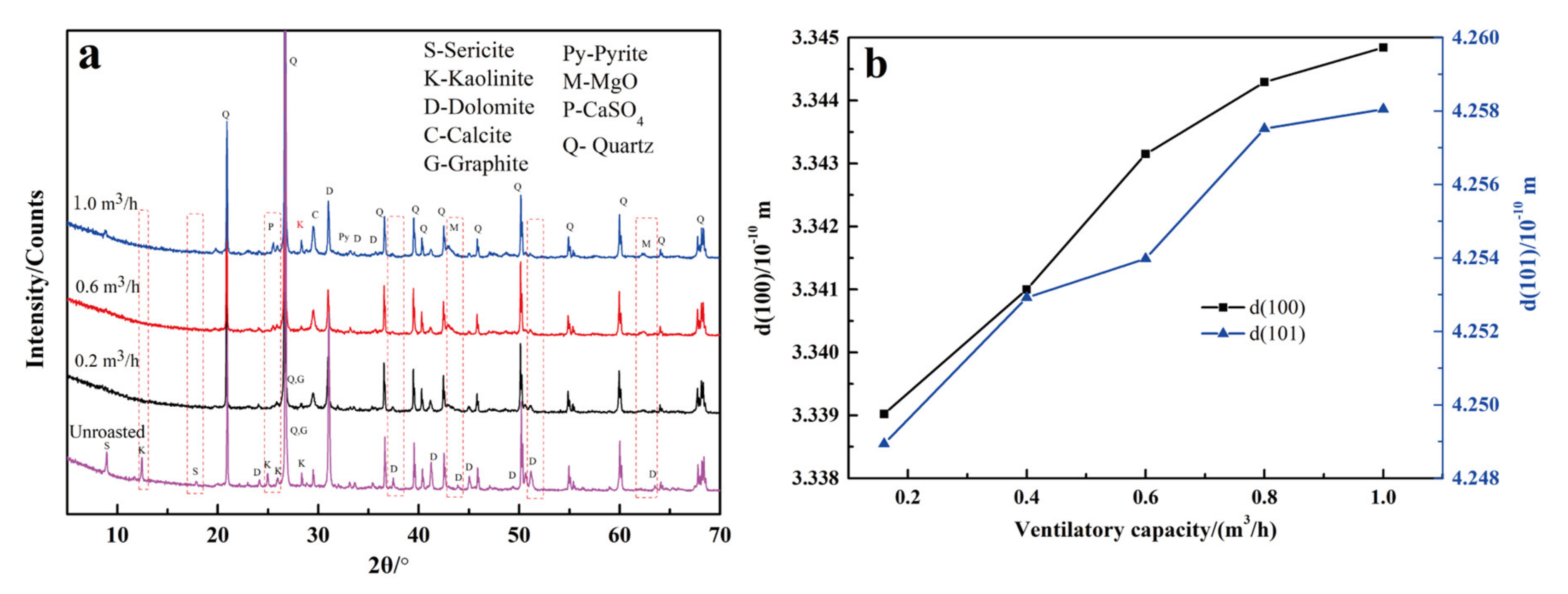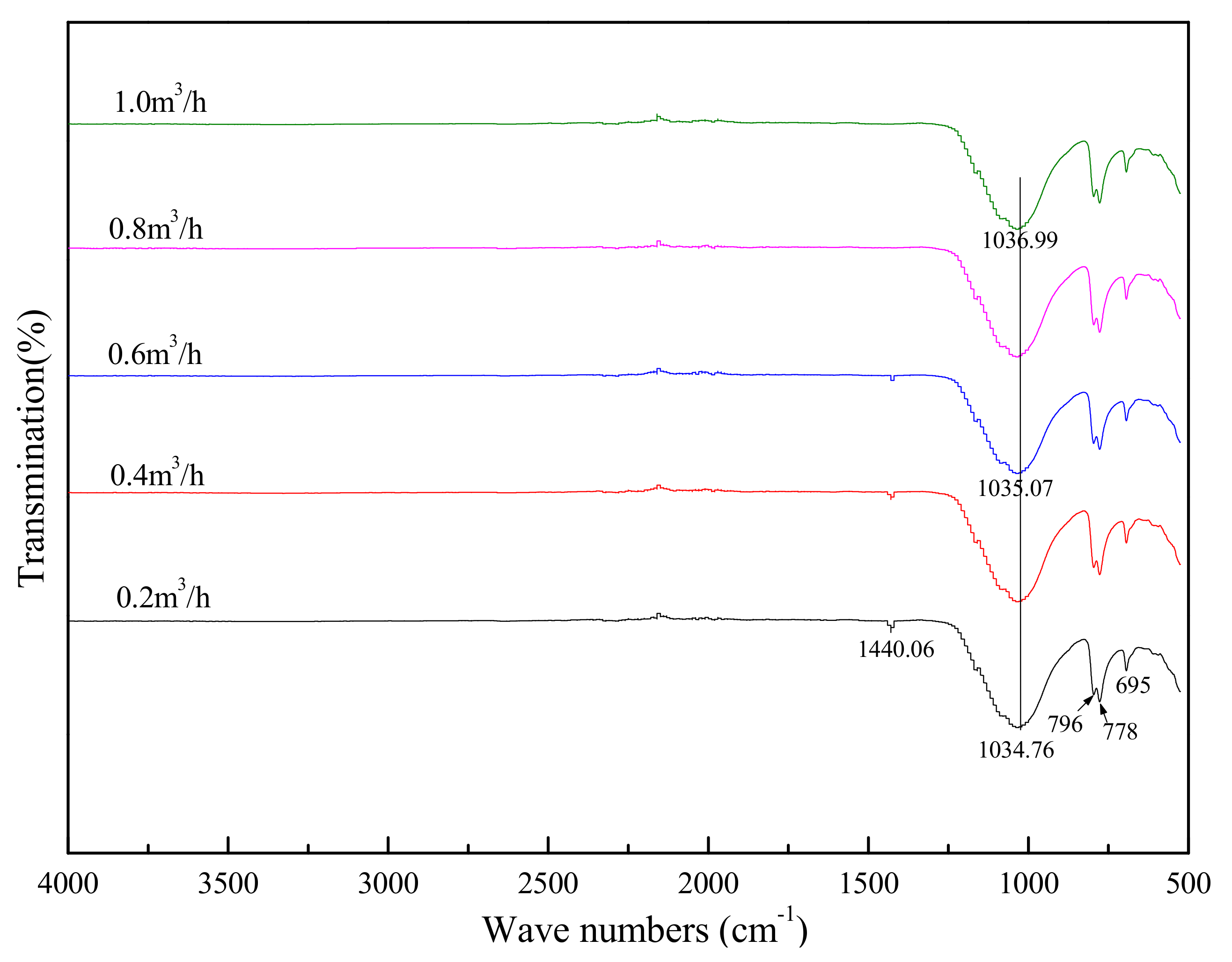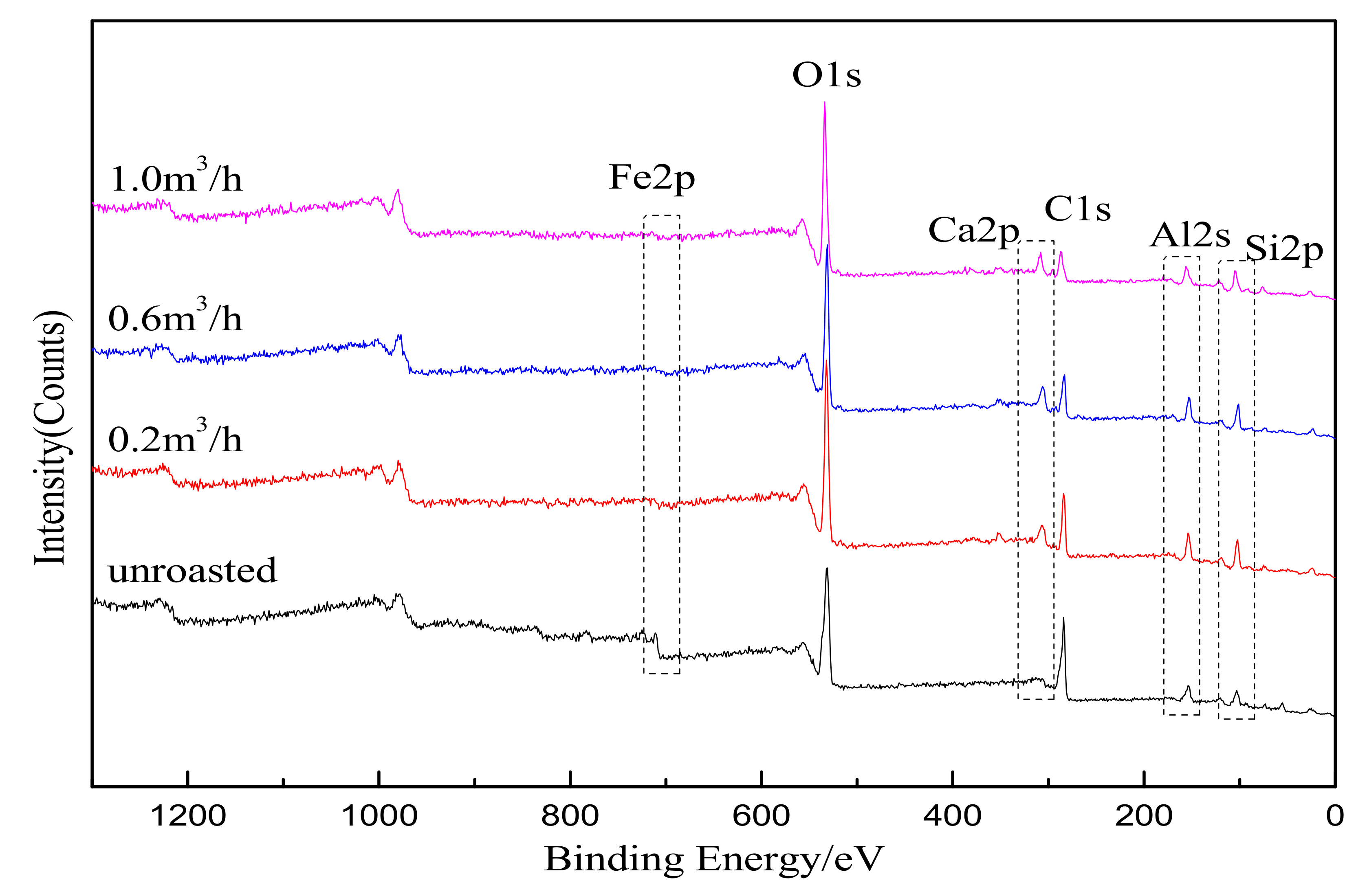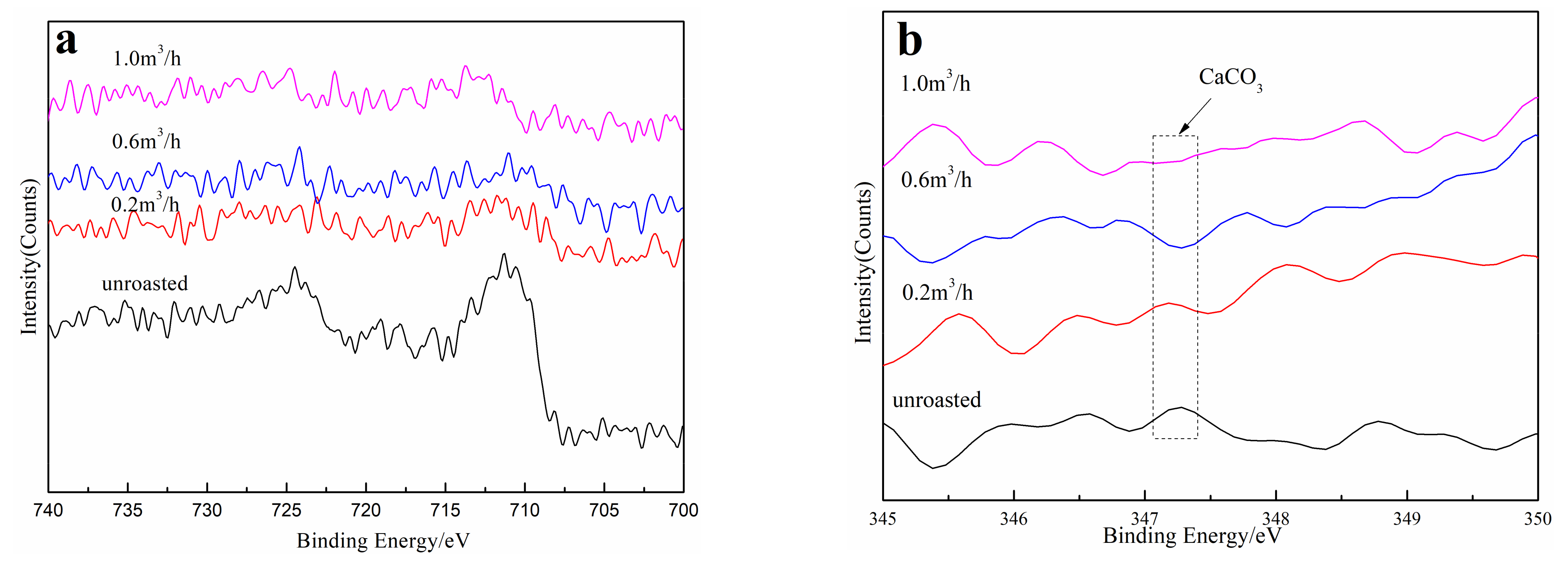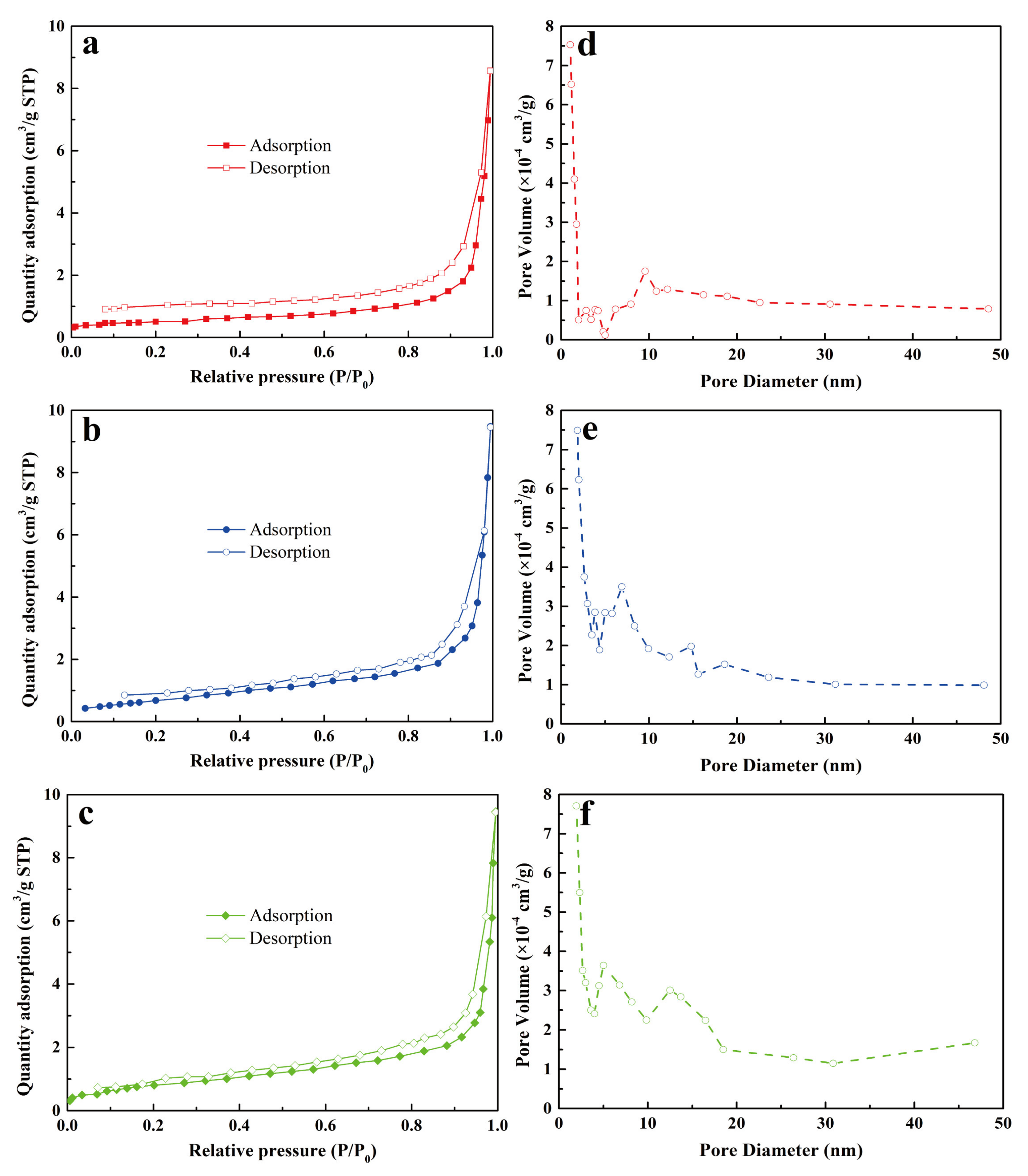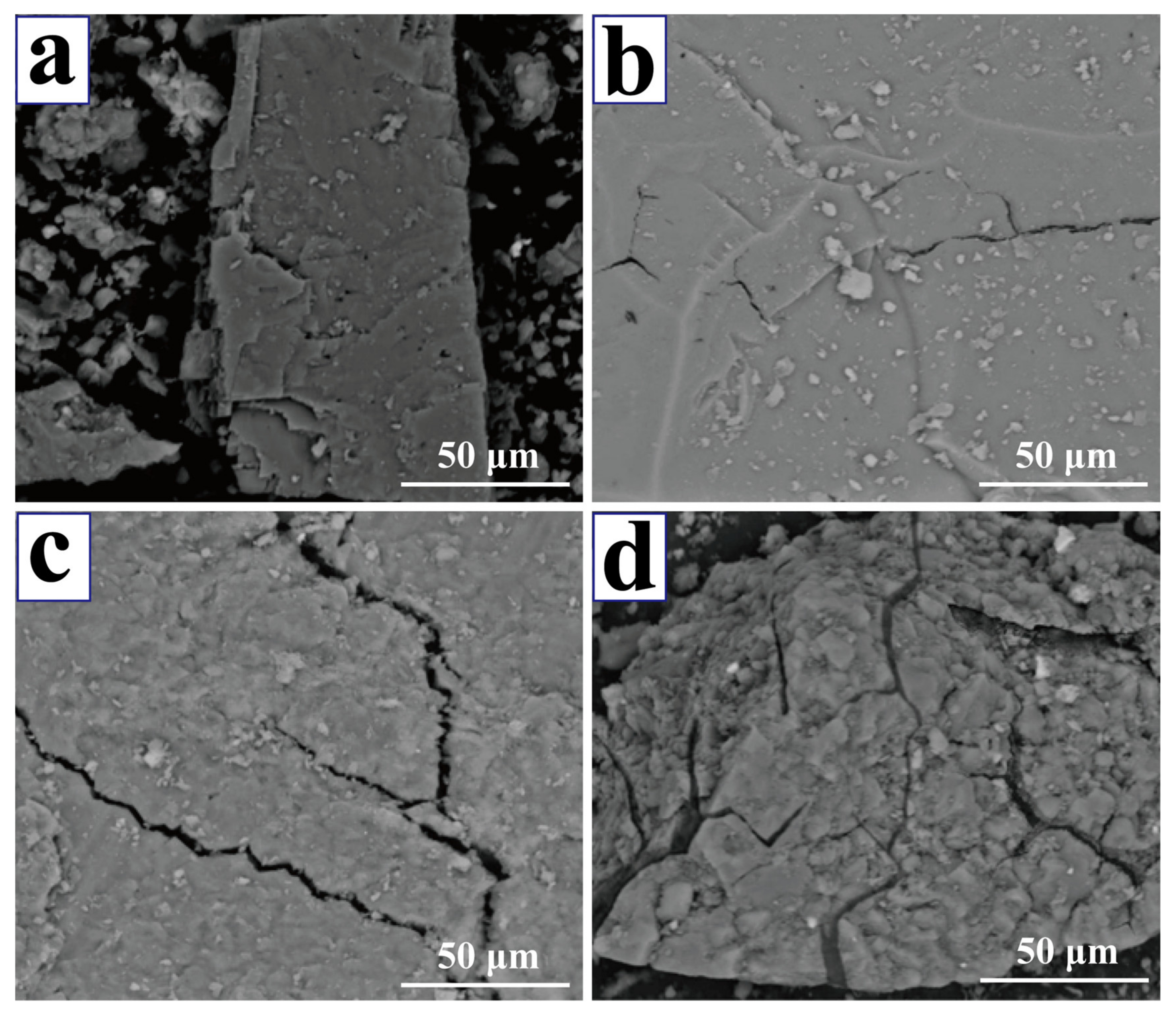3.1. Process Mineralogy of Raw Ore for Oxidation Roasting
The results of the process mineralogical analysis of the raw ore are shown in
Figure 1.
Gold exists in the form of independent mineral natural gold, the shape of which is relatively complex: mainly long angular granular, followed by branching and angular granular, and a small amount of wheat grain and sharp angular granular (
Figure 1a–c). The three natural gold grains in the ore are very fine, with diameters of less than 2.5 μm, and occur between quartz grains or wrapped in limonite. Natural gold can be divided into three types: single gold, intergrowth gold, and wrapped gold. Natural gold is mainly wrapped in detritus composed of limonite, carbonaceous material, pyrite, and quartz. Natural gold is associated with fine pyrite and carbonaceous material, accounting for 10.78%, as shown in
Figure 1c, of which, the other is associated with carbonaceous and siliceous slate clasts (carbonaceous material and quartz), and the other is associated with carbonaceous and siliceous slate clasts (quartz, limonite, and pyrite).
Carbon (organic carbon and graphite) is one of the most harmful components to the cyanide leaching process. The contents of graphite and organic carbon are 1.50% and 1.33%, respectively. The distribution characteristics of carbonaceous material in the ore are shown in
Figure 1d. Amorphous carbon occurs in the form of dust spots or other granules, and is evenly embedded with quartz or laminar, with a particle size of about 10 μM. Graphite or semigraphite is flaked, and the aggregate is heterogeneous granular. There was fine pyrite in the aggregate, displayed in broken stripes. The content of pyrite in the aggregate was about 1 to 3%. The content of single-crystal graphite was about 1 to 3%.
3.2. Effect of Oxidation Roasting Conditions on Leaching Behavior
Roasting operation is the most critical part of the process, and the roasting effect directly determines the gold leaching rate. The oxidation roasting process of carbonaceous fine-grained gold ore mainly involves the oxidation of carbonaceous matter and pyrite, as well as the decomposition of carbonate minerals such as dolomite and calcite. The gold leaching rate is used as the measure of the roasting effect. To determine the effect of various roasting parameters on the extraction of fine-grained gold from carbonaceous ore, and to identify the optimum conditions, single-factor tests such as roasting temperature, roasting time, and ventilation rate were carried out. The results are shown in
Figure 2.
Roasting temperature is one of the most important factors in the roasting process, as it determines the degree of chemical reaction and phase change between minerals. The effect of roasting temperature on the gold leaching rate was studied under a roasting time of 2.0 h and aeration rate of 0.8 m
3/h. The leaching conditions were: grinding to –0.074 mm, of 80% solids, pulp pH value of 11, sodium cyanide dosage of 1000 g/t, and leaching time of 24.0 h. The results are shown in
Figure 2a.
Figure 2a shows that the gold leaching rate was only 12.50% when the raw ore was directly cyanide leaching. With the increase in roasting temperature, the leaching rate of gold first increased and then decreased. As the roasting temperature was increased from 450 to 650 °C, the leaching rate of gold increased from 82.33% to 92.55%, which is an increase of 12.50%. However, when the roasting temperature was increased further, the leaching rate of gold gradually decreased. Therefore, the optimum roasting temperature range is 600 to 700 °C.
Roasting time determines the degree of phase change between the minerals in the ore. If the roasting time is too short, the carbon and pyrite in the ore are not completely oxidized, and the gold-robbing effect of carbon remains significant, resulting in a poor gold leaching effect. If the roasting time is too long, energy consumption is high, and sintering easily occurs.
Figure 2b depicts the experimental results of the effect of roasting time on gold leaching rate under a roasting temperature of 650 °C and aeration rate of 0.8 m
3/h.
Figure 2b shows that with an increase in roasting time, the leaching rate of gold first increased and then decreased slightly. As the roasting time was extended from 1.0 to 2.0 h, the leaching rate increased from 58.09% to 92.55%, which is an increase of 59.32%. When the roasting time was extended further to 3.0 h, the gold leaching rate decreased from 92.55% to 90.08%, which is a reduction of 2.67%. Therefore, the optimum roasting time is 1.75 to 2.25 h.
Ventilation is another one of the key factors in roasting. The oxidation of carbonaceous material and pyrite in ore is completed in an aerobic atmosphere. In addition, the increase in airflow through the roasting system is conducive to the decomposition of carbonate minerals in the ore, but if the flow rate is too high, a large amount of heat is lost. The ventilation rates of 0.2, 0.4, 0.6, 0.8, and 1.0 m
3/h were selected for the single-factor test using a temperature and residence time of respectively 650 °C and 2.0 h. The effect of aeration on gold leaching rate is shown in
Figure 2c. With increasing roasting ventilation, the gold leaching rate showed an increasing trend. When the aeration rate increased from 0.2 to 0.6 m
3/h, the gold leaching rate increased from 86.45% to 92.55%, which is an increase of 7.06%. However, when the gas flow rate was increased further, the gold leaching rate remained essentially constant, hence the optimal range of aeration flow rate was 0.4 to 0.8 m
3/h.
The practical problems with the oxidation roasting process are often more complex, and many factors need to be borne in mind in the selection of the optimum. According to the results of the single-factor experiments, (a) roasting temperature, (b) roasting time, and (c) roasting ventilation were selected as parameters for the orthogonal experiment. After grinding, the leaching test was conducted to investigate the interaction of various factors affecting the roasting effect. Each factor and level design in the test are shown in
Table 4. The results of the orthogonal test are shown in
Table 5. From
Table 5, the average leaching rate of gold was found to be 90.65%. The average leaching rate of gold from test 4 was the highest, reaching 92.58%, whereas that from test 9 was the lowest, at 87.04%. By comparing the effects of each level of the same factor one by one, the optimal level can be found, and then the range of each level can be calculated. The range can determine the primary and secondary influences of each factor. The range analysis results of gold leaching rate at different levels are shown in
Table 6. From
Table 6, roasting temperature, roasting time, the interaction between roasting temperature and roasting time, and range of ventilation are 2.15%, 1.33%, 1.38%, and 2.72%, respectively. Therefore, in the range of roasting conditions, aeration rate had the most significant effect on gold leaching rate, followed by roasting temperature, and the interaction between roasting time and roasting temperature, and roasting time had little effect.
3.3. Effect of Calcination Ventilation on Crystal Structure of Minerals
The orthogonal test of oxidation roasting showed that the aeration rate was the most important factor affecting the gold leaching effect. Therefore, the calcined samples under different calcination ventilation conditions (0.2, 0.4, 0.6, 0.8, and 1.0 m
3/h) were analyzed, and the phase and crystal structure changes of calcine under different calcination ventilation conditions were investigated. The results are shown in
Figure 3.
The characteristic diffraction peaks of sericite (d = 0.996 nm, d = 0.479 nm) disappeared (
Figure 3a), those of kaolinite became weak, and those of graphite weakened but still existed when the calcination ventilation was 0.2 m
3/h. This indicates that the sericite undergoes the dehydroxylation reaction under the low-ventilation conditions, and the reactions of kaolinite, dolomite, and carbonaceous material are incomplete. When the calcination ventilation increased to 0.6 m
3/h, the diffraction peak of graphite disappeared, indicating that the carbon had been completely oxidized. By this time, the characteristic diffraction peak of MgO appeared, indicating that part of the dolomite began to decompose. The characteristic diffraction peak of MgO was more obvious and the characteristic peak of CaSO
4 appeared when the ventilation continued to increase.
The diffraction angles of (100) and (101) crystal planes of quartz were 20.90° and 26.69°, respectively, when the calcination ventilation was 0.2 m
3/h. When the calcination ventilation was increased to 0.6 m
3/h, the diffraction angles of (100) and (101) crystal planes of quartz were 20.88° and 26.66°, respectively. The characteristic diffraction peak of quartz experienced a weak shift, but there was no diffraction peak of quartz, which indicated that the structure of quartz changed only slightly with the increase in ventilation. To further explore the influence of ventilation on the structure of quartz, the D100 and D101 crystal plane spacing values of quartz were analyzed, and the results are shown in
Figure 3b. The results showed that the D100 and D101 values of quartz increased from 0.2 to 1.0 m
3/h, indicating that the crystal structure of quartz gradually loosened with the increase in calcination ventilation. The reason for this finding may be that the crystal structure of quartz changes slightly during calcination.
3.4. Effect of Roasting Ventilation on Surface Groups of Minerals
The XRD results showed that the crystal structure of quartz changed with the increase in calcination ventilation. It was difficult to analyze the subtle changes due to the small differences in the XRD characteristic diffraction peaks. FTIR was used to analyze the calcined samples under different aeration rates (0.2, 0.4, 0.6, 0.8, and 1.0 m
3/h) to clarify the change rule of the surface groups of the calcined samples under different aeration rates. The results are shown in
Figure 4.
The characteristic peak of sericite disappeared at a wave number of 3640 cm−1 under different ventilation conditions, indicating that sericite completed the dehydroxylation reaction, which is consistent with the results of XRD analysis. With the increase in ventilation, the absorption peak of the CO32− group stretching vibration peak at 1440 cm−1 gradually weakened. When the ventilation rate was 0.6 m3/h, the absorption peak disappeared, indicating that carbonate minerals decomposed more, which is consistent with the XRD analysis. The wave number near 1035 cm−1 was caused by the antisymmetric stretching vibration peak of Si–O–Si. With the increase in calcination ventilation, the wave number of the absorption peak increased from 1034.76 to 1036.99 cm−1. The shift in the band to high frequency indicated that the bond length of Si–O shortened and the vibration frequency accelerated, which continuously improved the connection degree of the calcine network, which is consistent with the results of the XRD analysis. Therefore, the gold leaching rate also increases with the increase in the aeration rate.
3.5. Effect of Roasting Ventilation on the Valence Bond of Mineral Surface Elements
The XPS results of the calcine samples obtained by oxidation roasting of carbonaceous gold ore under different aeration rates are shown in
Figure 5.
The main elements in the XPS spectra of carbon-bearing gold deposits obtained by different calcination ventilation are Fe, Al, Ca, Si, O, and C. Among them, C1s was the main C element in the organic compounds contaminated on the sample surface and the C element in the raw ore, whereas O1s was the main O element in the organic compounds contaminated on the sample surface and the O element in the raw ore. To further understand the changes in the elements in carbonaceous gold ore under different roasting ventilation rates, the binding energies of inner layer electrons of the elements on the mineral surface under different roasting ventilation rates were compared. The results are shown in
Table 7.
From
Table 7, the shift in the amplitude of the characteristic peaks of O, C, Al, and Si in the samples under different ventilation rates was greater than 0.1 eV, indicating that the existing environment and binding morphology of O, C, Al, and Si changed significantly. The binding energies of Fe were 710.62, 712.07, 722.97, and 722.36 eV, respectively, showing that the characteristic peaks of Fe did not shift obviously at 0.2 m
3/h calcination ventilation, but when the calcination ventilation rates were 0.2, 0.6, and 1.0 m
3/h, new characteristic peaks with binding energies of 712.07, 722.97, and 722.36 eV formed. The binding energies of Ca are 348.08, 348.39, 348.88, and 349.00 eV, respectively. This shows that the characteristic peak of Ca underwent a weak shift with the calcination process under different calcination ventilation rates; that is, the existing state of Ca changed to a certain extent. To further explore the morphological changes in Fe and Ca under different calcination ventilation rates, narrow peak scanning of Fe and Ca was carried out, and the results are shown in
Figure 6.
The binding energy of Fe2p is 710.62 eV, which is close to the binding energy of Fe (2p
3/2) in FeS
2 (710.60 eV) (
Figure 6a), indicating that Fe on the surface of raw ore mainly exists in the form of FeS
2. When the calcination rates were 0.2, 0.6, and 1.0 m
3/h, the binding energies of Fe2p were 712.07, 722.97, and 722.36 eV, respectively. When the ventilation rate was 0.2 m
3/h, the binding energy of Fe2p was 712.07 eV, which is close to that of Fe
3O
4 (2p1/2), indicating that the surface Fe existed in the form of Fe
3O
4. The binding energy of Fe2p was close to that of Fe
2O
3 (2p1/2) (724.00 eV) when the ventilation rate was 0.6 and 1.0 m
3/h, which indicated that the carbonaceous gold ore was fully roasted, so the Fe element on its surface existed in the form of Fe
2O
3.
The binding energy (347.30 eV) of Ca (2P
3/2) in the unburned samples was similar to that of Ca (347.28 eV) in CaCO
3 (
Figure 6b), indicating that the Ca on the surface of raw ore existed in the form of CaCO
3. The binding energy of Ca (2P
3/2) was 347.28 eV at 0.2 m
3/h, which means that less decomposition reaction of CaCO
3 on the sample surface occurred. The binding energy of Ca (2p
3/2) changed to 348.05 and 348.11 eV when the calcination ventilation reached 0.6 and 1.0 m
3/h, indicating that CaCO
3 was completely decomposed. This shows that with the increase in calcination ventilation, the decomposition of calcite and dolomite can be promoted, which is conducive to the leaching of gold.
3.6. Effect of Calcination Ventilation on the Microporous Structure of Calcine
The aeration rate not only determines the concentration of oxygen in the roasting process but is also conducive to the timely discharge of CO
2 generated in the reaction and the decomposition of oxidant. The N
2-adsorption–desorption isotherms of calcine at different aeration rates (0.2, 0.6, and 1.0 m
3/h) and the total pore volume are shown in
Figure 7.
From the low-pressure section to the relative pressure (P/P0) of about 0.9, the adsorption capacity changed little. When the relative pressure exceeded 0.9, the adsorption capacity increased sharply with the increase in relative pressure. The desorption branch of the adsorption isotherm separated from the adsorption branch at a relative pressure of about 0.98. Over the entire pressure range, the separation of the desorption branch and the adsorption branch formed an obvious adsorption loop. When the relative pressure was less than 0.95, the adsorption and desorption branches were almost parallel. In the range of relative pressure from 0.95 to 1, both adsorption and desorption branches were vertical. Therefore, it was inferred that the channels in the calcine are slit or closed at one end, and the shape and size of these channels are non-uniform. Under 0.2 m3/h of ventilation, due to the lack of oxygen, the combustion reaction of raw ore is slow, a large amount of carbon cannot completely react, and the decomposition reaction of carbonate minerals cannot occur. The gold-robbing material can, therefore, not be completely eliminated, and the channels are closed at one end. This makes it difficult to leach gold from the calcine, which is one of the reasons for the low gold leaching rate.
With the increase in ventilation, hysteresis loops appeared in the curves shown in
Figure 7a–c. When the ventilation rate increased from 0.6 to 1.0 m
3/h, the shape of the hysteresis loop did not change significantly but slightly shifted to the right. Over the range of relative pressure 0.5 to 0.95, an obvious adsorption loop was observed. The hysteresis loop of 1.0 m
3/h calcine shifted to the right, which also showed that the increase in airflow is beneficial to the increase in pore diameter and number of channels. The increase in the number of pores in the calcine is beneficial to the improvement in the gold leaching rate, which is also consistent with the leaching test results.
According to the N
2 adsorption–desorption isotherms of calcine under different aeration rates, the pore size distribution and pore structure parameters of calcine under different aeration rates (0.2, 0.6, and 1.0 m
3/h) were obtained using the BJH method. The results are shown in
Figure 7d–f.
The total pore volume increased with the increase in aeration during roasting (
Figure 7d–f). However, when the ventilation rate increased from 0.6 to 1.0 m
3/h, the total pore volume increased slightly. When the aeration rate was 0.2 m
3/h, the micropores of 1 to 2 nm in the calcine accounted for the largest proportion due to the low oxygen concentration and incomplete chemical reactions. With the increase in the aeration rate, the number of 1 to 2 nm micropores in the calcine decreased sharply, while the number of 5 to 20 nm mesopores increased significantly. The results showed that with the increase in aeration, both oxidation and decomposition reactions occur, which increases the number of 2–10 nm mesopores in the calcine and helps to improve the gold leaching rate.
The BET specific surface area, total pore volume, and average pore size were calculated according to the pore size distribution of calcine under different calcination ventilation rates (0.2, 0.6, and 1.0 m
3/h). The results are shown in
Table 8.
Table 8 shows that when the ventilation rate increased from 0.2 to 0.6 m
3/h, the BET specific surface area, total pore volume, and average pore size increased by 1.06 m
2/g, 0.010 cm
3/g, and 2.15 nm, respectively, because the increase in calcination ventilation increased the oxygen concentration during calcination, which more fully calcined the sample. Therefore, increasing ventilation can greatly improve the pore structure parameters of calcined samples. However, the BET specific surface area, total pore volume, and average pore size increased by 0.0925 m
2/g, 0.000105 cm
3/g, and 1.06851 nm, respectively, when the aeration rate was increased to 1.0 m
3/h. The reason for this finding may be that when the ventilation rate reached 0.6 m
3/h, the oxygen demand of the roasting process was met. Therefore, increasing the aeration rate beyond this had little effect on the pore structure parameters of the roasted samples, which is consistent with the results of the roasting leaching test.
